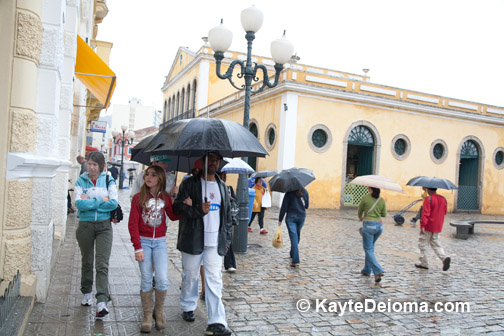
Things to Do on a Rainy Day in Florianopolis,
Santa Catarina, Brazil
Florianopolis Features:
Going Solo:
If You Go:
Story and photos by Kayte Deioma
Even though I write for Rainy Day Traveler, I prefer that it doesn’t rain when I’m on the road. It just makes the trip all around easier. But since I do travel for Rainy Day Traveler, I at least pack appropriate rain gear to go out and get the story. So waking up at the Majestic Palace Hotel in Florianopolis in the state of Santa Catarina, Brazil and looking out my 14th floor window at the lashing rain, I think to myself, what a perfect day for covering things to do in Florianopolis in the rain.
Despite being the state capitol, Florianopolis, or Floripa to locals, doesn’t have any large museums, usually a safe bet in inclement weather.
The Beiramar Shopping Mall is just across from the hotel, but there is no challenge in that. So I circle on my tourist map all the tiny museums and landmarks that look like they might provide at least a few moments respite from the deluge. With my heavy duty rain poncho covering both me and my backpack, and my camera in its own rain jacket, I go forth.
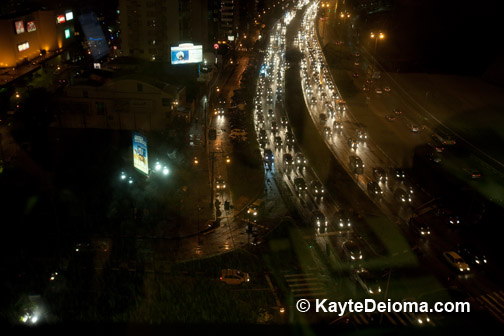
Under clear skies I would walk the distance to my first stop, but I am happy to have a taxi drop me off at the Sant’Anna Fort and Arms Museum, also known as the Museu da Policia Militar. The one-room fortress, with a strategic row of canons overlooking the North Bay at the foot of the Hercilio Luz Bridge manages to keep me dry for all of about 15 minutes. With a couple dozen antique weapons and a couple military uniforms on display, I am more interested in capturing the dreary view across the bay to the other side of this divided city.
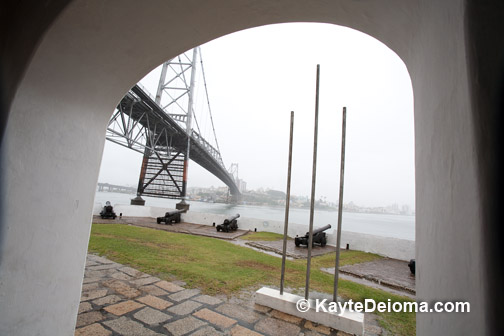
Santa Catarina Island is a stretch of Atlantic rainforest about 6 by 18 miles with 42 beaches and a freshwater lake. Florianopolis is situated mostly on the island, with another chunk of the city over the bridge on the mainland. Stretches of beach backed by high rise buildings face each other across the bay. Beyond the city limits, more laid back beaches, fishing villages, high end resorts, and some remaining stretches of forest line the many miles of coast.
Although one of the most popular tourist destinations for South Americans, this bit of paradise is relatively undiscovered by US travelers aside from a few surfers who make their way here for some of the continent’s best waves. Other tourists on such a miserable day head to the malls and bars. Not I.
Florianopolis is a modern city built up around a colonial core. Even if there were a taxi available outside the old fort, which there isn’t, it makes more sense to walk the few blocks to the heart of Old Floripa. Once I reach the pedestrian zone, I take advantage of each overhang and shop entrance to pause and frame a photo of the passing parade of umbrellas. I stroll through the Public Market, where the restaurants and bars between fish vendors, butchers and produce stalls are bustling with weather escapees.
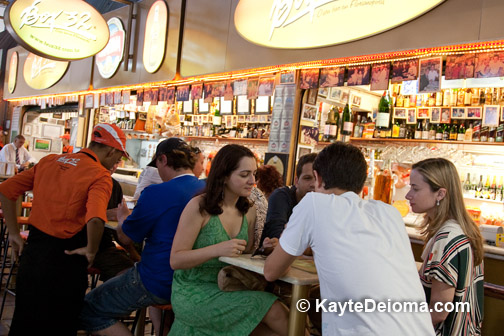
After a quick look into Sao Francisco Church, where half a dozen devout souls line the pews on this weekday morning, I reach my intended goal, the Museu Historico de Santa Catarina in the Palacio Cruz e Souza.
The former Palace of the Governor, now named after a famous local poet, is small as palaces go, but it’s the largest museum in town. The colonial building in candy pink and white was built in the mid-18th century and expanded over the years. You can see remnants of the earliest part of the stone and wood-beam structure downstairs in contrast to the ornate parquet floors and elaborately painted bas-relief ceilings upstairs. My Spanish comes in handy to read the descriptions of the furnishings and help me interpret what the creative English translation is supposed to say.
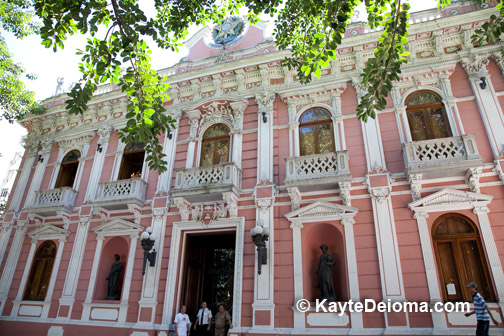
The tour of the Palace takes less than an hour and I am back outside on the Praca 15 do Novembro, also known as Fig Square. When I was here a couple days ago, the benches around the giant fig tree in the square were filled with people. Known as the “wishing tree,” local lore says that if you make a wish and walk around the tree seven times, your wish will come true – or you’ll win the lottery, or meet the man of your dreams…depending on which local you ask. In any case, I did my seven laps on my first visit.
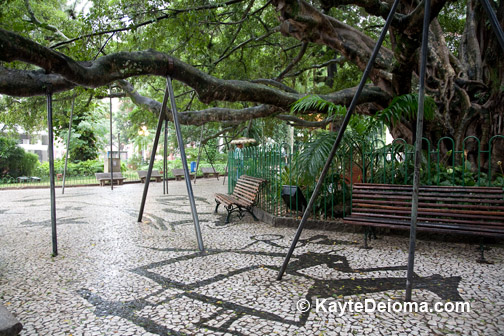
Now the the plaza around the hundred-year-old tree is abandoned except for a few hurried souls rushing past under umbrellas. The lack of crowds and the sheen of pooled water show off the designs of ships, fish and abstract characters on the black and white mosaic paths. A plaque on a wall tells me in Portuguese that the figures, representing local traditions, were created in 1965 by an artist named Hassis.
Speaking of artists, a bright splash of yellow that catches my eye turns out to be a painting that has been abandoned on a bench. A big yellow sun is rising or setting over a vibrant green sea with several small islands peaking up through the water, one supporting a single tree. A line from Macarthur Park pops into my head “someone left a cake out in the rain”…but the oil or acrylic on wood painting isn’t melting. Despite the drops of rain bouncing off its surface, its sun continues to shine brilliantly, brightening my day.
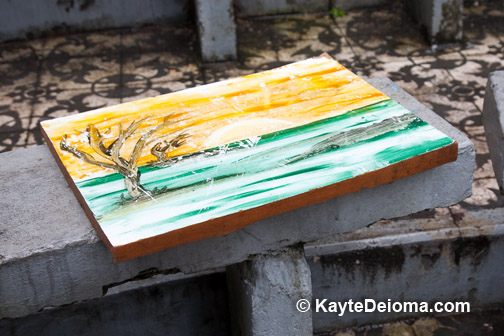
After a quick peak inside the Cathedral, I have one more stop on my list of things to do when it rains in Floripa, so I head for the Victor Meirelles Birthplace and Museum.
I know I’m close, but get a bit turned around when I find myself in front of a building that identifies itself on one side of the door as the Centro Cultural de Florianapolis, Archivo Historico Municipal, Galeria Municipal de Artes and Memorial Meyer Filho. I check my tourist map and find none of those listed. On the other side of the door under a colorful shield reads Prefeitura Municipal de Florianapolis, Secretaria da Administracao and Arquivo Historico. It’s not on the list of landmarks and attractions, but I find a yellow triangle on my map with the word Prefeitura. Now that I know where I am in relation to Victor Meirelles, I’m more curious about what’s inside the Florianopolis Cultural Center and Municipal Art Gallery AKA City Hall, so Victor can wait.
Inside, two local women are sitting at a folding table with a display of books. They turn out to be poets Janice de Bittencourt Pavan and Lorena Maria Tomasi Chiaradia who are putting in a volunteer shift selling books by local authors, including their own volumes of poetry.
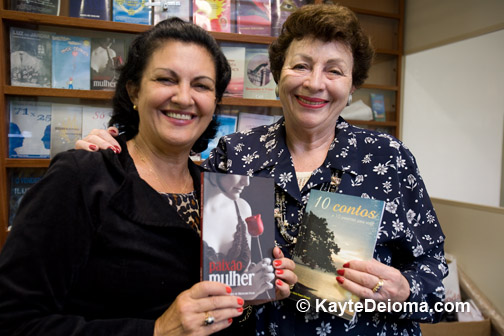
They direct me upstairs to the Pedro Paolo Vecchietti Municipal Art Gallery, where I find a temporary exhibit by Brazilian artist Antonio Vargas entitled Sushi with Mayonnaise. I raise my eyebrows at the age restrictions posted at the door.When I see the paintings incorporating graphic sex scenes among the kimono-clad characters in classical Japanese landscapes, I no longer wonder.
Back downstairs, I stop to chat with the ladies at the table, putting off leaving the shelter of the Cultural Center for a few more minutes. Lorena speaks Spanish, so I have no trouble communicating with her. Janice does not, so I try out the few words and phrases of Portuguese I’ve picked up over the last week in Brazil. With hand gestures and some creative guessing and translation assistance from Lorena, I answer their questions about what this American is doing in Florianopolis and why I am wandering around with a big camera in the rain.
When I ask for directions to the Museu Victor Mereilles, Janice decides it will be easier to show me. Since her shift is almost over, she leaves Lorena in charge and accompanies me the two blocks to the Meirelles Museum, but not before they each gift me with a volume of their precious poems.
Although located in a former home of the artist, there are no furnishings in the Victor Meirelles Museum, just a few rooms showing themed exhibits from the museum’s collection by the renowned local painter and one gallery with rotating paintings by other artists.
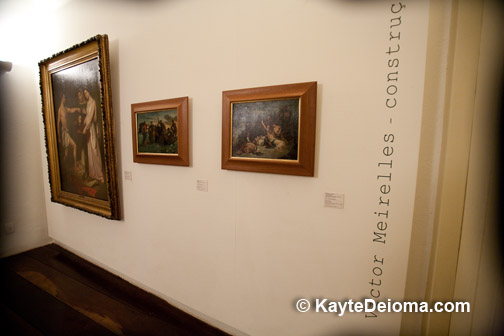
Without Lorena to translate, it takes a little longer for Janice and I to communicate, but I eventually understand that Victor Mereilles’ most famous painting is currently on temporary exhibit across town at the Santa Catarina Art Museum. For me to be in town and not see this most wondrous exemplar of Meirelles ‘ work would be a shame, Janice insists. So she calls her husband, just getting off work, to come drive us across town to the art museum. Not seeming the least bit put out, he scoops us from in front of the Meirelles Museum and escorts us on our mission to see The First Mass of Brazil, The Rebirth of a Painting.
We walk through several empty galleries that seem to be between exhibits to reach The First Mass of Brazil, which is, in fact, the only painting on display at the Santa Catarina Museum of Art on our visit. The painting takes up most of one wall, with the rest of the gallery dedicated to documenting the process of restoring the work of art to its former and current glory. Meirelles has depicted a priest raising a chalice over a bedecked altar in front of a large wooden cross with forest and mountains in the background. A close circle of Portuguese monks, knights and explorers bowed in prayer is surrounded by curious painted Indians.
Having gorged our eyes on the miraculous Meirelles restoration, we walk across the lobby to the CIC, the Centro Integrado de Cultura, taking a quick glance at the photos on display on our way to our ultimate goal, the Cafe.
Over Brazilian coffee and pao de queijo (cheese bread balls), my limited Portuguese seems to work just fine to learn about Janice’s work as a professor of writing, her husband’s law practice and the aspirations of their children. At the end of our lovely interlude they return me to the Majestic Palace. We exchange emails in the manner of people who have no expectation of further communication, but find in the exchange a potential that maintains the cosmic connection.
After such an adventurous day, I don’t have the energy to make a big deal out of dinner, so after I drop off my backpack and camera, I give in to the proximity of the Beiramar Mall and head to the food court. The sound of acoustic jazz guitar greets me as I come up the escalator and I look over to see a young man playing to one side of the dining area. I grab a couple meat and veggie pastries from a bakery stand and settle into a table nearby.
There’s something about Portuguese that makes it an especially beautiful language to sing, and as the young man’s sultry voice joins the guitar, I’m hooked. I know I should get back and download photos, but I’m here. In Florianopolis. In Brazil. In a mall. Being serenaded by a handsome Brazilian with a velvet voice. And just for now, I’m not going anywhere.
Having a cup of coffee with brother and sister Claudio and Ginha Andrade is not exactly like sitting down at your local Starbucks. It starts with a drive to the Santo Antonio de Lisbao neighborhood in Florianopolis on Santa Catarina Island in Brazil. There, in an old manioc flour mill, the local ceramic artist and his sister initiate guests in the art of creating a good cup of caboclo, a type of Brazilian shade-grown coffee.
The Andrade Mill and Old House is preserved as a working manioc mill, still powered by animals, as it has been since the Azoreans first began growing and grinding manioc here in 1748. The grinding of the manioc, or farinhada, is a community event that brings the whole neighborhood out to the farm to sing and dance while the animals grind the manioc into flour.
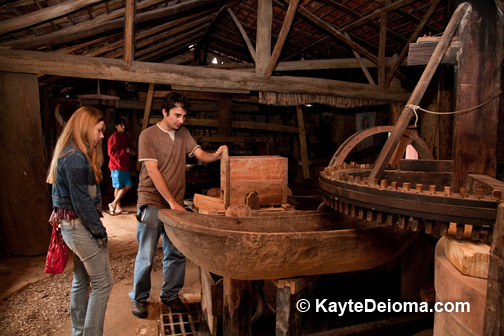
Eduardo Vieira is translating for me as we tour the mill. Claudio and Ginha speak only Portuguese, a language I haven’t yet mastered. Claudio’s ceramic sculptures and tiles are incorporated into the architecture and displayed in various nooks and crannies. Another curiosity is a collection of costumes and props from the local Boi de Mamăo folk festival.
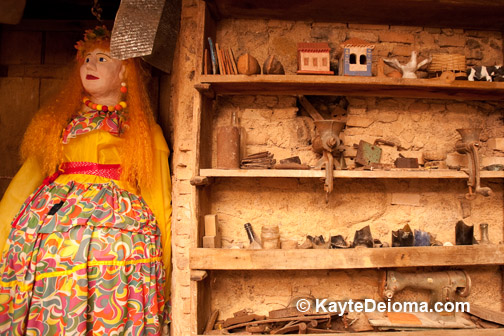
After we’ve explored the mill, we get down to the business of coffee. The first stop is to check out the coffea plants growing in the courtyard of the Old Mill House. The plants are about 7 or 8 feet tall and loaded with berries (also called cherries) in varying stages of ripeness, but mostly pretty green.
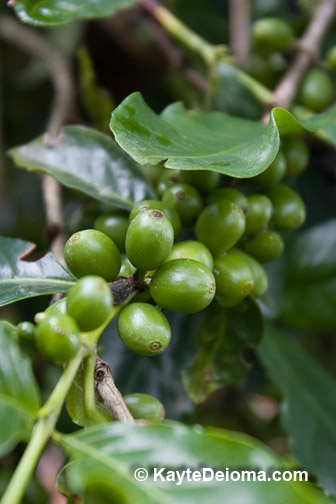
We follow our guides to a trough filled with ripe coffee berries in festive shades from orange-yellow to deep burgundy.
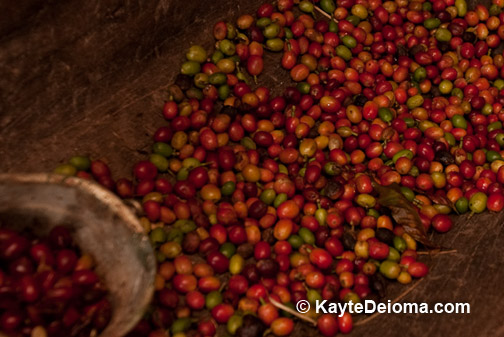
Obviously we don’t have time to sit and wait for coffee cherries to dry, so Ginha produces a basket of already dried out berries and adds them to a giant wooden mortar. Now the work begins as we take turns mashing the hulls off the fruit with a heavy four-foot-long pestle.
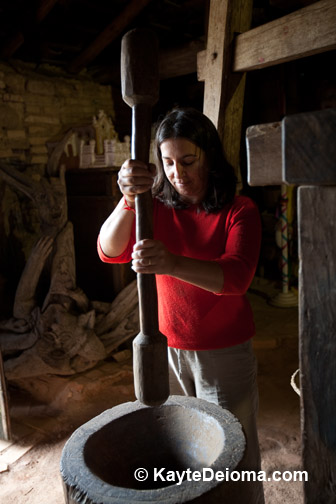
When she judges we’ve mashed enough, Ginha scoops the bits and pieces into a basket and takes us back out in the yard, where she demonstrates how to winnow the husks from the seeds. With the large flat basket extended in front of her she shakes the contents up into the air and blows on it to send the lighter husks falling to the ground, while the heavier seeds fall back into the basket.
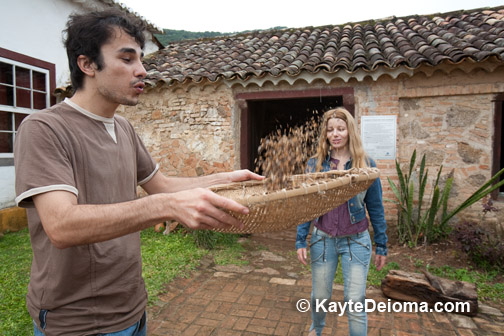
We each try to master the timing of shake, toss, blow, to separate the coffee kernels from the waste. When most of the outer matter has been cleared, we pick out the coffee beans, which are really more like seeds or cherry pits, and transfer them to a smaller basket to carry them to the kitchen.
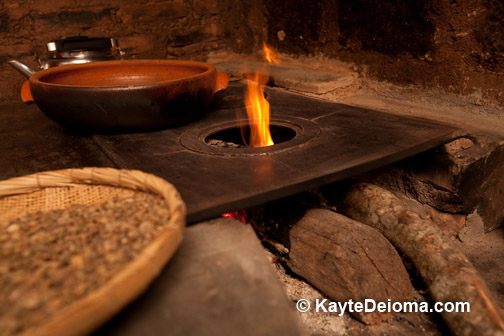
Claudio lifts the cover off the wood-burning stove to expose the flame, and the coffee beans are placed in a shallow clay bowl directly over the flame. We each take a turn keeping the beans moving.
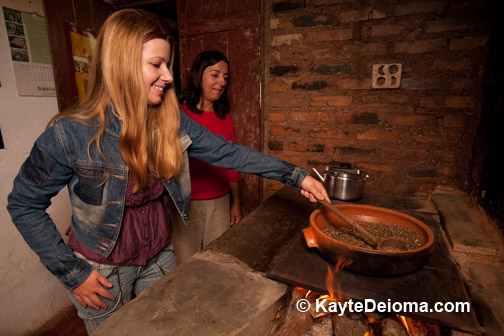
After 15 or 20 minutes of constant stirring to keep the beans evenly roasting, Claudio adds a generous scoop of sugar for the last few minutes over the flame to add the final dark sheen.
Still steaming, the fragrant gems are returned to the monster mortar and the workout begins again. No electric grinder here, just brute strength.
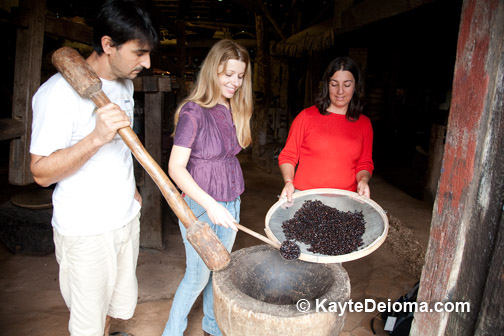
When Ginha declares the grounds fine enough, it’s back to the kitchen, where the filter-lined plastic drip coffee maker looks terribly modern set over a metal coffee pot. Hot water is added from a steaming kettle and the already strong aroma of coffee that lingered from the roasting gains another dimension.
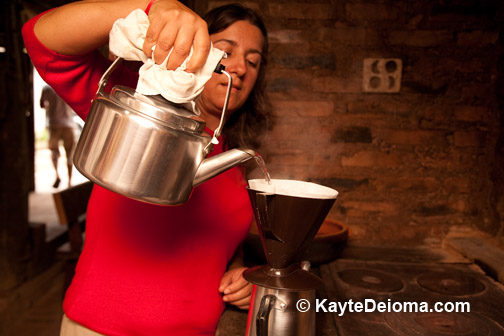
With the dark brew transferred to a thermos pitcher, we adjourn to the dining area, a cloth-covered table with wooden benches against exposed stone walls with wooden shutters. A portrait of Jesus in an ornate clay frame crafted by Claudio oversees our repast of cookies and caboclo coffee. I don’t know if it’s the sweat equity invested, or this place, or these warm-hearted people, but this elixir far transcends the common cuppa joe. The remaining ground coffee gets bagged and sent home with me as a tasteful souvenir. Good memories with every cup.
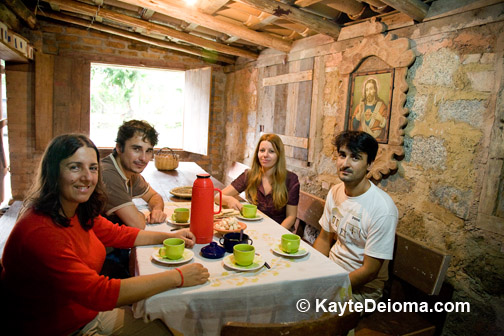
The Caboclo Coffee experience is one of several cultural immersion programs that visitors to Santa Catarina can enjoy. Other options include a clay sculpting workshop with Claudio at the Old Mill House; spending a day out with local fishermen; learning traditional methods to spin and dye wool from a local textile artist; making the berimbau rhythm instruments used in capoeira; the Oyster Experience in Ribeirao da Ilha including a visit to an oyster farm, learning to cook oyster dishes and visiting a local museum; and a cooking class featuring Brazilianized dishes from the Azores.
For more information or to book this experience, visit http://www.santacatarina.travel/experience.php?idioma=2